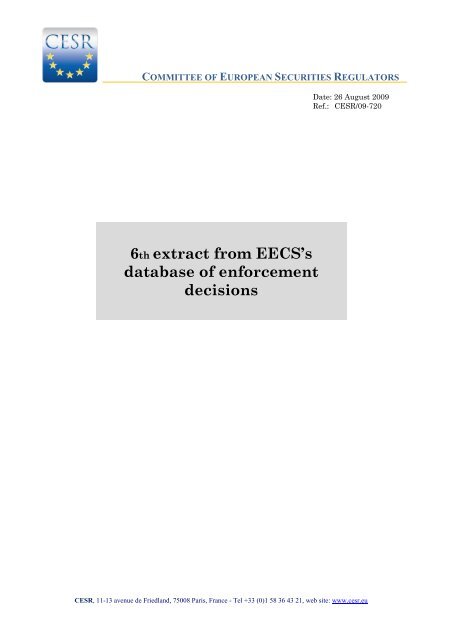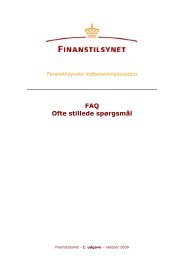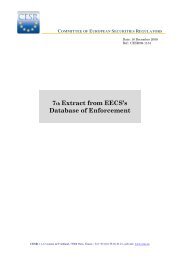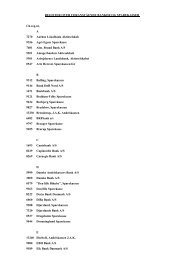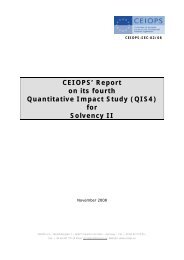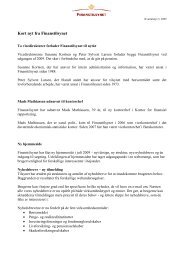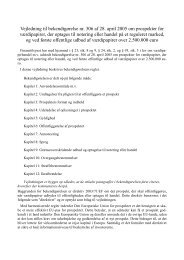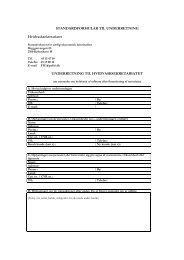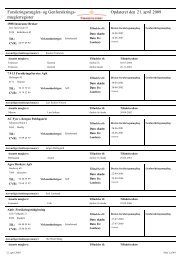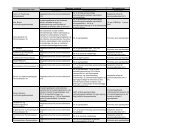View - Esma
View - Esma
View - Esma
You also want an ePaper? Increase the reach of your titles
YUMPU automatically turns print PDFs into web optimized ePapers that Google loves.
COMMITTEE OF EUROPEAN SECURITIES REGULATORSDate: 26 August 2009Ref.: CESR/09-7206th extract from EECS’sdatabase of enforcementdecisionsCESR, 11-13 avenue de Friedland, 75008 Paris, France - Tel +33 (0)1 58 36 43 21, web site: www.cesr.eu
Table of contentsINTRODUCTION ....................................................................................................................................................... 3DECISION REF.EECS/0809-01: IMPAIRMENT OF AVAILABLE FOR SALE EQUITY INSTRUMENTS . 4DECISION REF.EECS/0809-02: ACCOUNTING POLICIES FOR IMPAIRMENT FOR AVAILABLE FORSALE FINANCIAL ASSETS ..................................................................................................................................... 5DECISION REF.EECS/0809-03: IMPAIRMENT OF AVAILABLE FOR SALE FINANCIAL ASSETS......... 5DECISION REF.EECS/0809-04: CASH FLOW STATEMENTS .......................................................................... 7DECISION REF.EECS/0809-05: CLASSIFICATION AND VALUATION OF WRITTEN PUTS ONMINORITY INTERESTS ........................................................................................................................................... 8DECISION REF.EECS/0809-06: DISCLOSURE OF KEY MANAGEMENT PERSONNELCOMPENSATION AND RELATED PARTY TRANSACTIONS WITH KEY MANAGEMENT .................... 8DECISION REF.EECS/0809-07: CONTINGENT LIABILITIES .......................................................................... 9DECISION REF.EECS/0809-08: DISCLOSURES REGARDING SHARE CAPITAL ..................................... 102
IntroductionEU National Enforcers of financial information monitor and review financial statements andconsider whether they comply with IFRS and other applicable reporting requirements, includingrelevant national law.Operating under the operational CESR group charged with accounting issues, CESR-Fin, EECS is aforum in which all EU National Enforcers of financial information, whether CESR members or not,meet to exchange views and discuss experiences of enforcement of IFRS. A key function of EECS isthe analysis and discussion of decisions taken by independent EU National Enforcers in respect offinancial statements published by issuers with securities traded on a regulated market and whoprepare their financial statements in accordance with IFRS.EECS is not a decision-making forum. It neither approves nor rejects decisions taken by EUNational Enforcers who apply their judgement, knowledge and experience to the particularcircumstances of the cases that they consider. Relevant factors may include other areas of nationallaw beyond the accounting requirements. Interested parties should therefore consider carefully theindividual circumstances when reading the cases. As IFRS are principles based, there can be no oneparticular way of dealing with numerous situations which may seem similar but in substance aredifferent. Consistent application of IFRS means consistent with the principles and treatmentspermitted by the standards.Decisions taken by Enforcers do not provide generally applicable interpretations of IFRS, whichremains the role of the International Financial Reporting Interpretations Committee (IFRIC).As proposed in CESR Standard No 2 on Financial Information, „Co-Ordination of EnforcementActivities‟, CESR has developed a confidential database of enforcement decisions taken by individualEECS members as a source of information to foster appropriate application of IFRS. In response topublic comment to the Standard, CESR committed to publish extracts of the database to provideissuers and users of financial statements with similar assistance.Publication of enforcement decisions will inform market participants about which accountingtreatments EU National Enforcers may consider as complying with IFRS; that is, whether thetreatments are considered as being within the accepted range of those permitted by the standards orIFRIC interpretations. Such publication, together with the rationale behind these decisions, willcontribute to a consistent application of IFRS in the European Union.Decisions that deal with simple or obvious accounting matters, or oversight of IFRS requirements,will not normally be published, even if they were material breaches leading to sanctions. Theselection criteria are based on the above stated objectives, and accordingly, only decisions providingmarket participants with useful guidance will be published.On this basis, all cases submitted to the enforcement database are considered as appropriate forpublication, unless:- Similar decisions have already been published by CESR, and publication of a new one wouldnot add any substantial value to the fostering of consistent application;- The decision deals with a simple accounting issue that, even having been considered amaterial infringement, does not in itself have any accounting merit;- There is no consensus in the EECS to support the submitted decision.- A particular EU National Enforcer, on a grounded and justified basis, believes that thedecision should not be published;CESR will continue publishing further extracts from the database on a regular basis.3
Decision ref.EECS/0809-01: Impairment of available for sale equity instrumentsFinancial year end: 31 December 2007Category of issue: Impairment of available for sale equity instrumentsStandard involved: IAS 39Date of the decision: 13 November 2008Description of the issuer’s accounting treatmentThe issuer is a large life insurance and pension group with 3% of its financial assets, excludingderivatives, invested in equity instruments. In its 2007 consolidated financial statements, there wasa € 45 million charge to profit and loss relating to the impairment of equity instruments.The issuer stated, in its summary of accounting policies, that a significant or prolonged decline in thefair value of an equity instrument below its cost was considered to be objective evidence ofimpairment always resulting in a loss being recognised in the income statement.The issuer further disclosed in a note that equity securities held in an unrealised loss position belowcost for a specified period or which were significantly below cost at the balance sheet date wereevaluated for possible impairment.When asked to explain its treatment, the issuer noted that IFRS does not give any quantitativethresholds determining what should be considered „ significant‟ or „prolonged‟ and does not requirean entity to define these terms. The issuer added that, when conducting its impairment test, equityinvestments which had a market to book value of less than a certain percentage, unrealised losses ofmore than a threshold amount or were in an unrealised loss position for a specified period of timewere further analysed for evidence of impairment. The equity investments were impaired to fairvalue unless documentation is available supporting recovery of that value in the short term.The enforcement decisionThe enforcer did not accept the issuer‟s accounting treatment. In the view of the enforcer, asignificant or prolonged decline in the fair value of an equity instrument as determined by the issuerin the aforementioned situations is, of itself, objective evidence of impairment. No further evaluationis required or, indeed, permitted, in such circumstances.Rationale for the enforcement decisionIAS 39 paragraph 61 provides examples of what might be considered objective evidence ofimpairment for an investment in an equity instrument and which includes a significant or prolongeddecline in the fair value of an investment in an equity instrument below its cost. No furtherevaluation is required to establish whether the investment is impaired in such circumstances.The issuer should, therefore, impair its equity instruments where the decline in value is eithersignificant or prolonged (defined by the management judgement under IAS 39 paragraph 61)regardless of whether there is documentation supporting recovery of their fair value in the shortterm.* * *4
Decision ref.EECS/0809-02: Accounting policies for impairment for available for salefinancial assetsFinancial year end: 31 December 2007Category of issue: Accounting policies for impairment of available for sale financial assetsStandard involved: IAS 39Date of the decision: 13 April 2009Description of the issuer’s accounting treatmentThe issuer, a bank, disclosed in its 2007 financial statements that equity instruments classified asavailable for sale assets were considered to be impaired when there was objective evidence that theassets were impaired and where there was both a significant and prolonged decline of fair valuebelow costs.The category of available for sale assets represented 5% of the bank‟s total assets.Applying this policy, the issuer did not recognise any impairment losses in its interim financialstatements of June 2008.The enforcement decisionThe enforcer did not accept the accounting policy applied by the issuer and disagreed with thecriteria applied to the determination and recognition of impairment losses in respect of equityinstruments.Rationale for the enforcement decisionIAS 39 paragraph 61 states that, in addition to the types of events described in paragraph 59,objective evidence of impairment for an investment in an equity instrument includes informationabout significant changes with an adverse effect that have taken place in the technological, market,economic or legal environmental in which the issuer operates, and indicates that the cost of theinvestment in the equity instrument may not me recovered. The paragraph goes on to say that “Asignificant or prolonged (emphasis added) decline in the fair value of an investment in an equityinstrument below its cost is also objective evidence of impairment”.The standard is clear that the decline needs only to be significant or prolonged to be consideredobjective evidence of impairment. There is no requirement that both criteria are met.IAS 39 does not indicate quantitative thresholds that may satisfy the criteria of „significant‟ or„prolonged‟. Issuers should, however, refer to the thresholds they apply in their description of therelevant accounting policy in accordance with IAS 1 paragraph 122 1 .* * *Decision ref.EECS/0809-03: Impairment of available for sale financial assetsFinancial year end: 31 December 2008Category of issue: Impairment of available for sale financial assetsStandard involved: IAS 39Date of the decision: 1 April 2009Description1 With reference to IAS 1 issued by the IASB in September 2007 and endorsed in December 2008.5
The issuer, a bank, has interests in equity instruments classified as available for sale financialassets in accordance with IAS 39. These stocks are all listed on an active market.The issuer explains, in the description of its accounting policy for available for sale financial assets,that a “significant or prolonged decline of the fair value of an equity instrument triggers a furtheranalysis and that an impairment is recognised, if necessary, after this further analysis.” This analysisis not described in the notes to the financial statements.The issuer explained its accounting treatment by reference to IAS 39 paragraph 59. This paragraphstates that financial assets are impaired if, and only if, there is objective evidence of impairment as aresult of one or more events that occurred after the initial recognition of the asset (a „loss event‟) andthat that loss event (or events) has an impact on the estimated future cash flows of the financialassets that can be reliably estimated.The issuer argued therefore, that, where there is a significant or prolonged decline in the value of anequity instrument, as referred to in paragraph 61 of the standard, further analysis must beundertaken to determine whether that decline has an impact on the estimated future cash-flows ofthe financial assets.The issuer referred to the IFRIC Update dated March 2004, which, it argued, indicated that thewording “a significant or prolonged decline in the fair value of an investment in an equity instrumentbelow its cost is also objective evidence” represented an unequivocal trigger for consideration of themeasurement principles set out in paragraphs 67 and 68 of the standard. The issuer considered thatan “unequivocal trigger” means that a further analysis should be undertaken.The enforcement decisionThe enforcer did not accept the issuer‟s accounting policy that a significant or prolonged decline inthe fair value of an equity instrument prompted further analysis as the decline is, of itself, objectiveevidence of impairment. No further evaluation is required or, indeed, permitted in suchcircumstances.Rationale for the enforcement decisionIAS 39 paragraph 58 states that, at the end of each closing period, an entity should assess whetherthere is any objective evidence that a financial asset or group of financial assets is impaired. If suchevidence exists, the entity shall, for available for sale financial assets, apply IAS 39 paragraph 67 todetermine the amount of the impairment loss. According to paragraph 67, “when a decline in the fairvalue of an available for sale financial asset has been recognised in other comprehensive income andthere is objective evidence that the asset is impaired, the cumulative loss that had been recognised inother comprehensive income shall be reclassified from equity to profit or loss as a reclassificationadjustment even though the financial asset has not been derecognised”.Therefore, according to the enforcer, there is a direct and explicit link between the existence of an“objective evidence of impairment” and the recognition, in profit or loss, of the cumulative lossrecognised in other comprehensive income.A reading of IAS 39 paragraph BC107 indicates that paragraph 59 focuses on the assessment ofimpairment of debt instruments and paragraph 61 on equity instruments. Paragraph 61 states that,in addition to the type of events listed in paragraph 59, for equity instruments, other changes in theeconomic, technological etc, environment can also be considered objective evidence of impairment.The paragraph goes further and states that a significant or prolonged decline in the fair value of aninvestment in an equity instrument below its cost is also objective evidence of impairment.The enforcer disagreed that the assessment of impairment of equity instruments should be madesolely on the basis of paragraph 59 and believed paragraph 61 to be the relevant paragraph.According to the enforcer, the purpose of paragraph 61 is to provide guidance on the application ofthe principle established in paragraph 58. Specifically, paragraph 61 underlines the fact that, for6
equity instruments that are listed on an active market, a decline (either significant or prolonged) inmarket value below cost is the ultimate indication that the equity instruments are impaired.The enforcer also disagreed with the issuer‟s interpretation of wording included by IFRIC in itsMarch 2004 update. According to the enforcer, “unequivocal trigger for measurement” means thatparagraphs 67-68 should be applied without further analysis.* * *Decision ref.EECS/0809-04: Cash Flow StatementsFinancial year end: 31 December 2006Category of issue: Cash flow statementsStandard involved: IAS 7Date of the decision: 2 June 2008Description of the issuer’s accounting treatmentThe issuer presented a non-cash element of a sales transaction as a cash transaction in itsconsolidated cash flow statement. The cash transaction related to the sale of a subsidiary as follows:- The issuer had granted a loan to a subsidiary. As a result of the sale of the subsidiary to athird party, the loan was no longer eliminated on consolidation but recorded on the balancesheet. The movement in the book value of the loan, a non-cash transaction, was classified asa cash outflow from investing activities in the cash flow statement.- The aggregate amount of cash received as consideration for the sale of the subsidiary wasreported as an incoming cash flow from investing activities and was not recorded net of thecash and cash equivalents disposed of with the subsidiary. Furthermore, disposal costs werenot taken into account.The enforcement decisionThe enforcer found that the issuer had failed to comply with IAS 7 in a number of respects, giventhat a non-cash element of a cash transaction had been reported as a cash transaction in the cashflow statement.Rationale for the enforcement decisionAs a result of the non compliance with IAS 7 cash flows from operating activities were materiallyoverstated and the cash flows from investing activities were materially understated.The cash receipt from investing activities was incorrect as it was not reported net of cash and cashequivalents disposed of as required by IAS 7 paragraph 16 and IAS 7 paragraph 42. In addition, theissuer had not disclosed, in aggregate, the amount of the assets and liabilities other than cash orcash equivalents in the subsidiary over which control is lost as required by IAS 7 paragraph 40d.* * *7
Decision ref.EECS/0809-05: Classification and valuation of written puts on minorityinterestsFinancial year end: 31 December 2007Category of issue: Minority interests and puttable instrumentsStandard involved: IAS 32, IAS 39Date of the decision: 21 October 2008Description of the issuer’s accounting treatmentThe issuer had acquired several companies over a number of years, including the reporting year inquestion.The issuer‟s strategy is to acquire the majority of the acquiree‟s shares but to leave a minorityinterest outstanding for a limited amount of time, after which it acquires those interests too. To thisend, the issuer assumes an unconditional liability to purchase the remaining outstanding shares foran amount determined by the results achieved by the acquired companies, largely, revenue andearnings growth.Under the terms of the contract, the issuer can choose whether to pay for these minority shares in cashor in its own shares. If the issuer opts for payment by way of its own shares, the number of shares tobe paid are calculated at the time of the purchase of the minority interests.In its financial statements, the issuer classified the minority interests as part of group equity,disclosing the existence of unconditional liabilities in a note to the accounts.The enforcement decisionThe enforcer found that, in accordance with IAS 32 paragraph 23, the minority interests should beclassified in the balance sheet as a financial liability as the shares are to be paid for either in cash ora variable number of the issuer‟s own equity instruments.Rationale for the enforcement decisionIAS 32 paragraph 23 stipulates that a contract which contains an obligation for an entity topurchase its own equity instruments for cash or another financial asset cash gives rise to a financialliability for the present value of the redemption amount. This is the case even if the contract itself isan equity instrument.When the financial liability is recognized initially under IAS 39, its fair value (the present value ofthe redemption amount) is reclassified from equity. Subsequently, the financial liability is measuredin accordance with IAS 39.* * *Decision ref.EECS/0809-06: Disclosure of key management personnel compensationand related party transactions with key managementFinancial year end: 31 December 2007Category of issue: Share-based paymentStandard involved: IAS 24Date of the decision: 6 January 2009Description of the accounting treatment8
The issuer granted shares to key management as part of their remuneration package. The relatedcosts were not included in the total of the compensation disclosed for key management personnel butwere noted separately.The issuer subsequently bought back some of the shares from key management but did not discloseeither the number of shares involved or the amount for which they were repurchased .Both the issue and the subsequent repurchase of the shares were significant in relation to the totalremuneration package for key management personnel.The enforcement decisionThe enforcer concluded that the issuer should disclose the information as required by IAS 24paragraphs 16 and 17(a).Rationale for the enforcement decisionIAS 24 paragraph 16(e) requires disclosure of key management personnel compensation in total for anumber of identified categories, including share-based payments. Compensation for share-basedpayment, although provided elsewhere, was not included in the total compensation disclosed andwas significant in relation to that amount (20%).IAS 24 paragraph 17 also requires information about transactions and balances that is necessary foran understanding of the potential effect of the relationship with related parties on the financialstatements. Disclosure should include the amount of the transactions. The enforcer concluded thatboth the number of shares bought back and the amount for which they were purchased should alsobe disclosed in accordance with this paragraph.* * *Decision ref.EECS/0809-07: Contingent liabilitiesFinancial year end: 31 December 2007Category of issue: Contingent liabilitiesStandard involved: IAS 37Date of the decision: 28 April 2008DescriptionThe issuer builds, develops and manages airports.In May 2004, a roof-section of the boarding area of a terminal collapsed killing 4 people andwounding 4 others. The accident resulted in the temporary closure of the terminal and led to legalaction against the issuer.Both the investigation and the reconstruction were still in progress when the 2007 accounts werepublished and no action had yet been brought in connection with the accident. Experts werecontinuing with their appraisals, mainly in connection with the expert report that was to bepresented to the civil courts determining the cause of the accident and assessing the respectiveresponsibilities of the various parties involved. The report was expected in the summer 2008.Financial damages arising from the accident consisted of additional costs and operating lossesrelating to the unavailability of the building. The real nature and extent of the damages, includingwhether they qualify for compensation and the details of any compensation payments made had yetto be established. The issuer considered that, at the current stage of proceedings, there was norequirement to record the impact of the accident in the financial statements.9
Compensation agreements had been arranged with the victims‟ claimants, all of which were coveredby the issuer‟s insurance policy. The insurers were also party to these transactions. In each case,compensation paid by the insurance agents was subject to a waiver of any judicial proceedings orappeals against the issuer and its insurers. If compensation is ultimately payable to third parties bythe issuer, this is expected to be covered by the insurance policies it has taken out .The issuer considered that the conditions for recognising a provision or disclosing a contingentliability, particularly the conditions set out in paragraphs 14 and 28 of IAS 37, had not been fulfilled.Hence, the issuer did not recognise any provision in respect of the accident in its 2007 accounts nordid it disclose any related contingent liability. Furthermore, the issuer did not disclose its underlyinganalysis of the situation in the notes to its 2007 financial statements.The enforcement decisionThe enforcer agreed that, in accordance with IAS 37 paragraph 14, the conditions for establishing aliability were not fulfilled. The enforcer did, however, conclude that a contingent liability should bedisclosed as required by IAS 37 paragraph 28.Rationale for the enforcement decisionIAS 37.14 requires a provision to be recognised when an entity has a present obligation as a result ofa past event; it is probable that an outflow of resources embodying benefits will be required to settlethe obligation and a reliable estimate of the obligation can be made.At the date of the financial statements, there was no current obligation for the issuer. In particular,no action had been brought in connection with the accident. It was not yet probable that an outflowof resources would be required to settle the obligation. In any event, if compensation were payableto third parties by the issuer, the insurance policies were expected to cover the outflow. In theenforcer‟s view, no provision was required.The enforcer was, however, of the opinion that IAS 37 paragraph 28 applied to the case and that theissuer should disclose a contingent liability.The fact that the real nature and extent of the damages, including whether they qualify forcompensation and details of any compensation payments remained to be established all indicated thelevel of uncertainty attaching to the issue. In the view of the enforcer, however, the degree ofuncertainty was not such that the possibility of an outflow of resource could be considered remote.Had this been the case, no disclosure under IAS 37 paragraph 28 would have been required.* * *Decision ref.EECS/0809-08: Disclosures regarding share capitalFinancial year end: 31 March 2008Category of issue: Financial instruments and share capitalStandard involved: IAS 32Date of the decision: 30 November 2008Description of the issuerThe issuer, a closed-ended fund, has share capital comprising two subscriber shares of €1 each whichdo not participate in the profits of the issuer, and in excess of 50 million participating preferenceshares of no par value, which are classified on the face of the Balance Sheet as a component of„Participating Shareholders‟ Equity‟.The issuer‟s financial statements stated that its participating and subscriber shares are classified asequity in accordance with the issuer‟s articles of association. The participating preference shares areto be redeemed when the issuer‟s useful life of 15 years expires.10
The issuer argued that the participating preference shares be presented as equity on the basis thatthis was the legal form of these instruments.The enforcement decisionThe enforcer did not concur with the analysis that the participating preference shares should bepresented as equity. Rather, the enforcer was of the opinion that these shares were a financialliability of the issuer in accordance with IAS 32.Rationale for the enforcement decisionIAS 32 paragraph 18 provides that „The substance of a financial instrument, rather than its legalform, governs its classification on the entity‟s balance sheet‟. Similarly, IAS 32 paragraph 15 requiresthat an issuer of a financial instrument „ shall classify the instrument … on initial recognition as afinancial liability, a financial asset or an equity instrument in accordance with the substance of thecontractual arrangement and the definitions of a financial liability, a financial asset and an equityinstrument.‟The enforcer concluded that the shares should be shown as a financial liability as they aremandatorily redeemable upon expiration of the issuer‟s limited life of 15 years (IAS 32 paragraph11).* * *11


